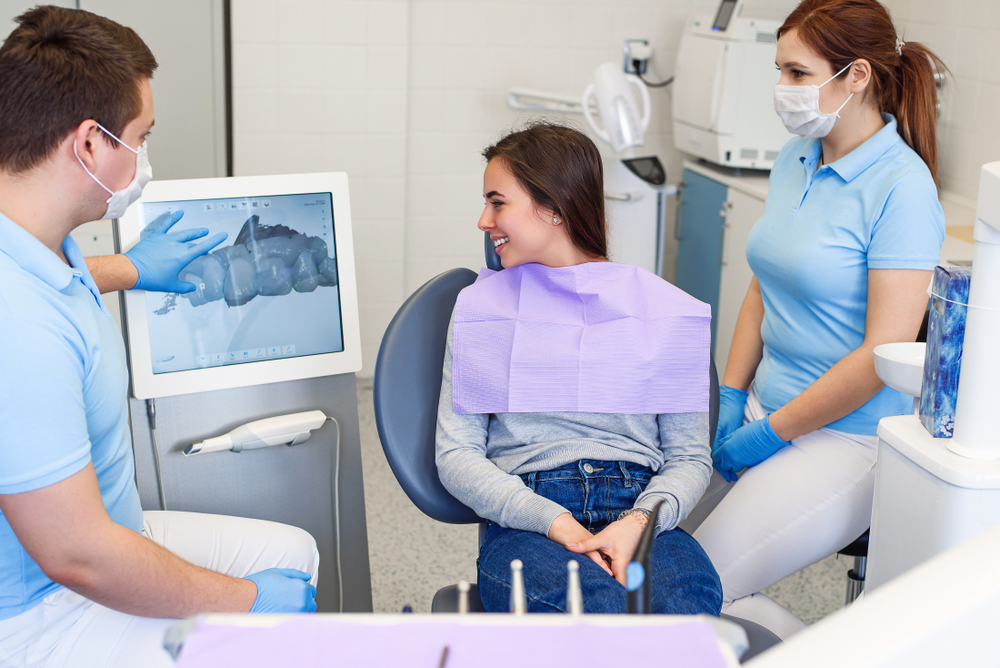Digital dentistry involves the detection of oral problems, planning of treatment processes, design, and production of treatment materials using computer-aided modeling and processing technologies. All records and designs obtained in these processes can be stored long-term in a computer environment for future reference when necessary.
Which Treatments Can Be Applied Under Digital Dentistry?
Digital dentistry can be utilized for the placement of fillings requiring higher resistance to forces in cases where ideal treatment cannot be achieved with conventional methods. It allows for the creation of inlay and onlay restorations when ideal treatment cannot be achieved with filling applications. The design and production of crowns and bridge treatments planned on teeth or implants can be carried out in a computer environment. The production of splints used in various joint diseases can be performed in this way.
Transparent trays for orthodontic treatment purposes can be produced in cases of minimal misalignments. In addition to all these treatments, digital dentistry allows for the production of guide appliances used to increase the success of implant surgery and minimize treatment time.
How Does the Treatment Process Proceed with Digital Dentistry?
After the initial examination, a digital measurement is taken from the mouth using a camera. Then, the designs of the treatment alternatives to be applied are prepared via computer programs, and a digital design model is created. In cases where the positions of the teeth are suitable, the prepared design is tried on the teeth. If the design placed in front of the planned line of the teeth hinders the proper execution of the trial application, minimal adjustments may be necessary on the teeth before the trial session.
After the trial session, necessary adjustments for the teeth are made to prepare the site for the restoration to be applied. Then, changes made on the teeth are recorded by taking a new digital measurement and adapted to the prepared design.
Temporary restoration is applied to the teeth to support aesthetics and functional properties until the permanent restoration is applied. During this process, the permanent restoration prepared in the digital environment is processed in the laboratory using various methods. In the next treatment session, the prepared permanent restoration is tried in the mouth, and aesthetic and functional compatibility checks are performed. Finally, when the form of the restoration is adjusted to provide ideal fit, the restoration is permanently bonded to the teeth.
What Materials Can Designs Created with Digital Systems be Processed into?
The designs can be processed into dental composite materials, glass ceramics, and zirconia, mainly. The choice of these materials is based on various factors to determine the most suitable for the treatment. Particularly, the location of the teeth to be treated and the intensity of the forces applied to these teeth are taken into account.
For example, in aesthetic corrections on anterior teeth, composite fillings are often preferred. These can match the natural tooth color and can be shaped to achieve aesthetic results. In posterior teeth, however, more durable and resistant materials may be required. In such cases, stronger materials like glass ceramics or zirconia may be preferred.
The dentist considers these factors when creating the treatment plan with the patient. The most suitable material for the location of the teeth and the patient’s needs is selected. Thus, successful results are achieved both aesthetically and functionally, and the treatment process is completed with the satisfaction of the patient.
What are the Advantages of Digital Dentistry?
- Since measurement, design, and processing processes are carried out via digital systems, the treatment can be completed in a shorter time.
- Digital measurement minimizes the negative effects caused by deformations of traditional measurement materials, allowing for maximum compatibility with the teeth.
- Discomfort due to nausea reflex during the application of traditional measurement materials is not observed in digital measurement processes.
- Since all measurements of the design created during the processing of the restoration are accurately transferred, the need for trial sessions for adjustments is minimized.
- Before starting the treatment process, the design aspect of the treatment plan can be conveyed to the patient through digital measurements and various profile photos. Thus, the patient can easily have an idea about the aesthetic changes that the restoration to be applied can create.
- Unless there is a condition that prevents the trial application, the outcome of the treatment can be tried in the mouth using a silicone key before abrasive procedures are performed on the teeth. This allows for an objective evaluation of the design both aesthetically and functionally.
Free Consult
Fill out the form, one of our officials will call you as soon as possible and let’s start planning your treatment by answering all your questions.
Or Call Us +90 537 957 20 37


